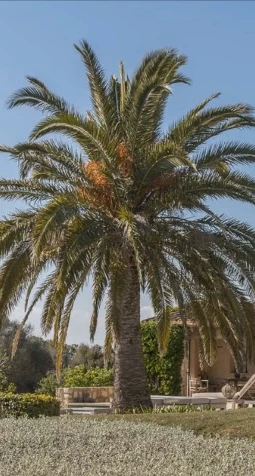
The Canary Island Date Palm (Phoenix canariensis)—my favorite landscape palm—is native to the Canary Islands and was introduced to the Mediterranean region by the British in the 19th century. With its long, fan-like fronds and distinctive trunk—resembling a pineapple in its youth—it has become a structural staple in gardens worldwide. Reaching heights of up to 20 meters, it’s a popular choice for large gardens and parks, though in smaller gardens, it tends to dominate the entire space.
Closely related to the true date palm (Phoenix dactylifera), which produces edible dates, the Canary Island Date Palm differs in that it does not yield ripe fruit in regions like Southern Europe. This is due to the absence of prolonged temperatures above 70°C in the palm’s heart for several months. Instead, it is valued for its resilience, beauty, and longevity.
Beyond aesthetics, the palm offers ecological benefits. Its spring blossoms provide vital nourishment for bees and other pollinators. In favorable conditions following rainy summers, it may even bloom a second time in autumn—making it a fascinating addition to eco-conscious garden designs.
Though a slow grower, the Canary Island Date Palm eventually achieves a majestic stature. Regular pruning keeps its form clean and enhances its striking appearance. Its hardiness makes it ideal for Mediterranean climates and sheltered spots in temperate regions.
Despite its robustness, this non-native palm faces threats worldwide. In Southern Europe, the introduction of true date palms from Morocco—often bypassing strict health certifications—has brought the highly destructive red palm weevil (a Malaysian beetle). This pest, lacking natural predators in Europe, has caused widespread devastation and can only be managed with pesticides.
Europe is home to only two native palm species: Chamaerops humilis (predominantly found) and Phoenix theophrasti (native to Crete).